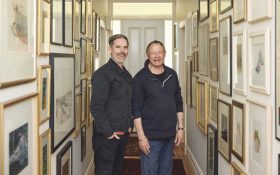Nothing is more depressing for artists and curators than the study published in the Empirical Studies of the Arts which showed the typical museum-goers spends an average of just 17 seconds looking at an individual painting.
That study – published in 2001 – came before the rise of Instagram and the selfie effect which pushed audiences further towards a been-there-done-that culture driven by FOMO (Fear of Missing Out).
But art is the ideal place to get off the speeding treadmill and there is an increasing effort to persuade art audiences to slow down.
Slow Art is part of the Slow Movement, which was founded in 2004 by philosopher Carl Honore. The movement began as a reaction against fast food, encouraging homegrown, homemade food, made slowly and with love. The Slow Movement grew quickly (pun intended) to encompasses – among other things – slow exercise, slow dating, slow parenting and slow fashion. There is even a long-form print magazine dedicated to slow journalism, encouraging readers to go deeper into a topic than the 140 character snippets that our brains are becoming accustomed to.
Avoiding overload
Phil Terry discovered the power of slow art when he visited an exhibition at the Jewish Museum in New York in 2008. Usually he left museums feeling overwhelmed and exhausted but on this occasion he spent an hour in front of one painting – Hans Hofmann’s Fantasia – and emerged feeling energised.
After his experience with Fantasia, Terry wanted to share the feeling of slowly ingesting artworks with other art-world outsiders, so he started Slow Art Day.
‘People usually go to a museum, see as much as they can, get exhausted, and don’t return,’ Terry said. ‘Slow Art Day energises people.’
Slow Art Day has now grown to be an annual global event with hundreds of museums and galleries around the world participating. This year’s event will be held on Saturday April 8 and several Australian galleries are involved.
Participants are encouraged to visit a gallery and look at no more than 5 pieces of art – each for at least five minutes.
The National Portrait Gallery in Canberra is holding a special event where visitors can view a selection of works, slowly, then meet afterwards to share ideas and discuss the experience.
‘The slow art movement has been around for some time now,’ said Krysia Kitch, manager of learning programs at the National Portrait Gallery. ‘I believe that there is a reaction to the fast pace of life where daily experience is constantly being mediated by a screen. Slowing down to look at art allows us to really look closely, find connections to our lives and experiences, interpret the art work from different perspectives and reflect on our lives.
‘We can discover that the human experience crosses boundaries of age, time, culture and gender. It allows us to explore difference as well as commonality, to empathise with deep emotions of joy, despair, passion, anger, love and disillusionment.’
The psychological benefits of slow art
It is not just arts professionals who would like slower viewing of art. James Pawelski, Director of the Positive Psychology Center at the University of Pennsylvania, points out the psychological benefits of art come from slower viewing.
‘When you go to the library, you don’t walk along the shelves looking at the spines of the books and on your way out tweet to your friends, “I read 100 books today!’’ Yet that’s essentially how most people experience a museum.‘They see as much of art as you see spines on books,’ said Pawelski, who studies connections between positive psychology and the humanities, told the New York Times. ‘You can’t really see a painting as you’re walking by it.’
Pawelski said it’s still a mystery why viewing art in this deliberately contemplative manner can increase well-being. That’s what his research is trying to uncover. He theorized, however, that there is a connection to research on meditation and its beneficial biological effects. In a museum, though, you’re not just focusing on your breath, he said. ‘You’re focusing on the work of art.’
Previous research, including a study at the University of Michigan, has already suggested that museums can serve as restorative environments. And a study by the London School of Economics and Political Science has found that visiting museums can have a positive impact on happiness and self-reported health.
Looking at art slowly has similar benefits to re-reading a favourite book or listening to your favourite album and discovering more things to love about the music, said Kitch. ‘With other art forms – literature, dance, music – we would never make a decision about a work’s value (whether we like it or not) after just 15 seconds, yet that is the average time people in an art gallery spend in front of an art work, even one as famous as the Mona Lisa in the Louvre.’
Images are more important and prevalent than ever, but we rarely stop to take the time to properly absorb what we are looking at. ‘We live in an image saturated world and need to be able to read images in a nuanced way, yet more and more we behave as if a quick scan can provide all the information we need, and we know that if we scan a written document we don’t absorb everything that is being said,’ she said. ‘Looking at art slowly allows us to see more, speculate, imagine and encourages curiosity.’
Read: Six reasons visitors reject your audio guide
Encouraging slow audiences
How do galleries and museums persuade audiences to slow down? Increasingly galleries are introducing programs to enable slower experiences of arts.
Lawrence Wilson Art Gallery at the University of Western Australia runs a 45 minute sessions where participants spend half the time in observation of five selected works, and the remaining time discussing their observations and responses.
Manager, Audience Development, Caine Chennatt said enabling audiences to interact successfully with art was increasingly understood as part of a gallery’s role.
‘Importantly, I believe, we in galleries and museums need to recognise, understand and be open to the possibility that each person may create a very different meaning and interpretation of the artwork we are exhibition, bridged mostly by their experiences and their current emotional state. This means we have to see ourselves not just as knowledge-caretakers with valuable information to impart didactically, but perhaps instead, a meaningful facilitator for self-discovery and relationships to the communities we exist in, using the art we have access to as the platform for engagement.’
The National Portrait Gallery advises visitors to either focus on one small area of the gallery or go to a couple of galleries and only look at one or two works that attract them for some reason, and spend longer with those works.
They also consider the way that the artwork is displayed, said Kitch.
‘In some exhibitions, particularly when they have a contemplative theme, for example Tough and Tender in 2016, the works are not crowded on the wall but are given space to be viewed, the blank walls between setting up a rhythm with the works that encourages thought and doesn’t quickly replace one image with another.’
Ample seating is a simple technique to help audiences spend time with a single artwork. Pass outs (so audiences can take a break) and multiple viewing tickets remove the pressure that suggests a viewer hasn’t got their money’s worth if they don’t look at every work in the show.
Slow Art Day is held on Saturday April 8.





